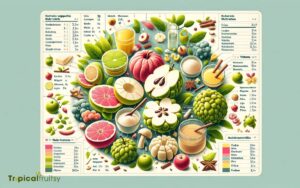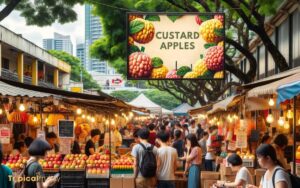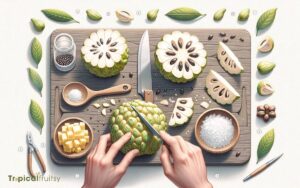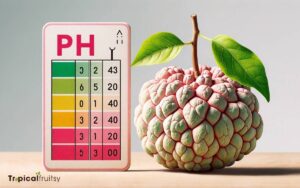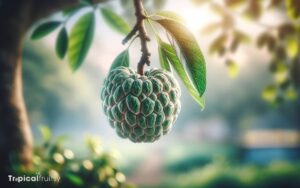How to Prune Custard Apple Tree? 3 Easy Steps!
Pruning a custard apple tree is a vital process to maintain its health and optimize fruit production.
The ideal time for pruning is during the dormant stage, usually in late winter or early spring before new growth begins.
Use clean, sharp pruning shears for small branches and a saw for larger limbs. Remove dead, diseased, or crossing branches to improve air circulation and sunlight exposure.
After pruning, apply appropriate wound dressings if necessary and ensure proper hydration to facilitate healing. Pruning should be done with care to avoid over-pruning, which can stress the tree.
Here are some quick steps:
Properly pruned custard apple trees are more vigorous and produce higher quality fruits.
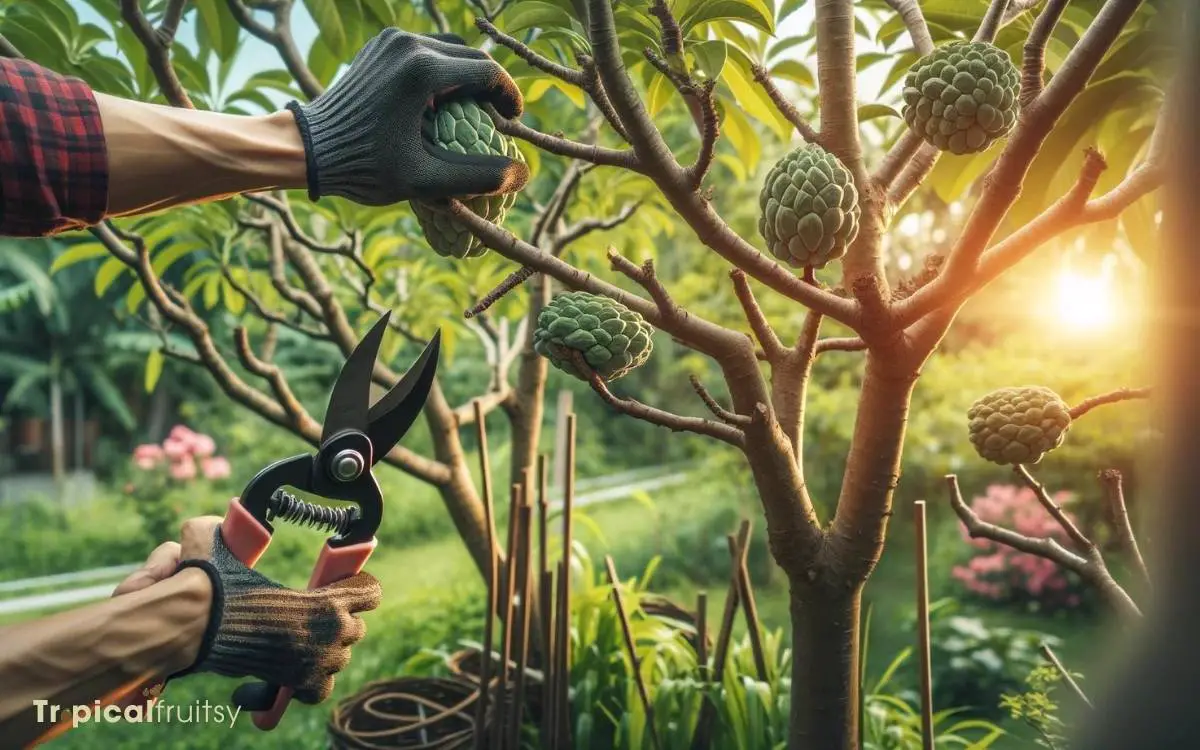
Key Takeaway
Understanding Custard Apple Trees
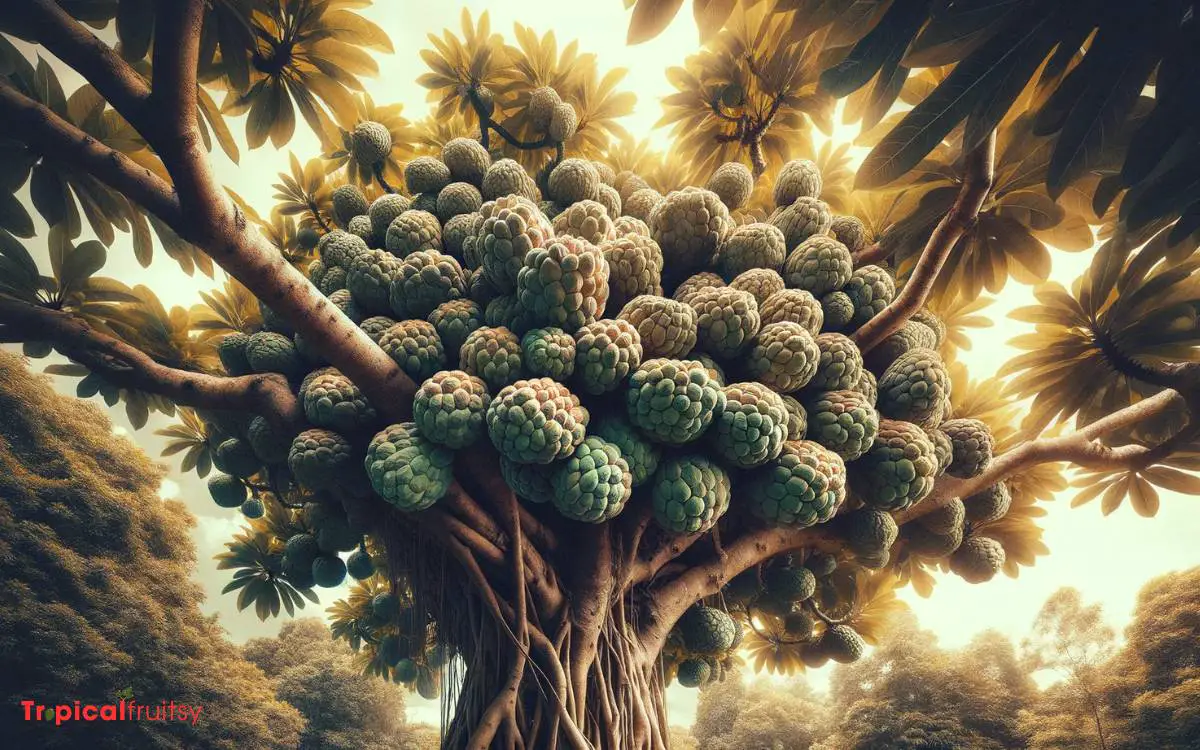
Before I dive into the specifics of pruning, it’s important that I understand the growth habits and structure of custard apple trees.
These trees are known for their moderate to fast growth rate and can develop a naturally irregular branching pattern if not pruned correctly.
Custard apple trees exhibit sympodial growth, which means the main stem grows to a certain point and then stops, giving rise to a lateral branch that continues the growth. This pattern repeats throughout the tree’s structure.
As a result, understanding the primary scaffold branches and identifying the terminal buds are vital to effective pruning.
I’ll also need to recognize water sprouts and suckers, which are vigorous vertical growths that can divert energy from fruit production and must be removed for optimal tree health.
Ideal Pruning Season

I’ve found that the best time to prune a custard apple tree is during its dormant period, typically after the harvest season and before the onset of spring growth. This timing allows for the tree to recover and channel energy into new growth effectively.
Factors like regional climate and the tree’s specific growth cycle must be considered to optimize the pruning process.
Best Time Frame
Pruning my custard apple tree is most effective during the late winter or early spring, just before the new growth starts.
This timing allows me to assess the tree’s structure without the obstruction of leaves and to make precise cuts that will heal quickly as the growing season commences.
It’s crucial to avoid pruning too early in the winter, as the wounds can be exposed to harsh conditions, which might lead to damage or disease.
Similarly, late pruning, after new shoots have developed, can limit the tree’s fruit production for the season.
The dormant period offers the ideal window where the risk of pest infestation or fungal infection at the pruning sites is minimized, ensuring a healthier recovery for the tree.
Dormant Period Importance
Understanding the dormant period’s significance, I recognize it as the ideal time to prune my custard apple tree, since it minimizes stress and promotes vigorous growth.
This phase typically occurs when the tree has shed its leaves and its growth processes slow down.
Pruning during dormancy prevents the loss of sap that can weaken the tree and also reduces the likelihood of disease transmission, as many pathogens are less active in colder weather.
Moreover, without foliage, the tree’s structure is fully visible, allowing for more precise cuts and better shaping.
Strategic removal of branches during this time encourages the tree to direct energy to the remaining branches, resulting in stronger, more productive growth in the spring.
Hence, timing my pruning right during dormancy is crucial for the tree’s health and yield.
Climate Considerations
Having established the importance of the dormant period, I’ll now consider my local climate to determine the ideal pruning season for my custard apple tree.
Climate plays a pivotal role in the timing of pruning, as trees respond differently to temperature and weather patterns.
- Frost Risk: Prune after the last frost to prevent damage to new growth.
- Growth Cycle: Aim for late winter or early spring when the tree is still dormant.
- Rainfall Patterns: Avoid wet seasons to reduce fungal infection risks.
- Temperature Fluctuations: Stable, mild temperatures are optimal for recovery.
- Regional Variations: Consult local agricultural extensions for area-specific advice.
Understanding these factors ensures my custard apple tree gets pruned at the right time.
Let’s move on to the tools I’ll need for an effective pruning session.
Necessary Pruning Tools

I’ll need a few essential tools to effectively prune my custard apple tree. These include sharp secateurs, sturdy gloves, and a reliable pruning saw.
It’s crucial that my secateurs are always sharp to ensure clean cuts. This will prevent damage to the branches and reduce the risk of disease.
The gloves must be durable, offering protection against thorns and rough bark while maintaining dexterity.
My pruning saw will come in handy for thicker branches. It should have a curved blade for better cutting angles and teeth that are designed for both green and woody stems.
Having the right tools ensures that I’m prepared for any pruning task, whether it’s removing dead wood, shaping the canopy, or encouraging better fruit production. Each tool plays a vital role in the health and productivity of my custard apple tree.
Step 1: Assessing Tree Health
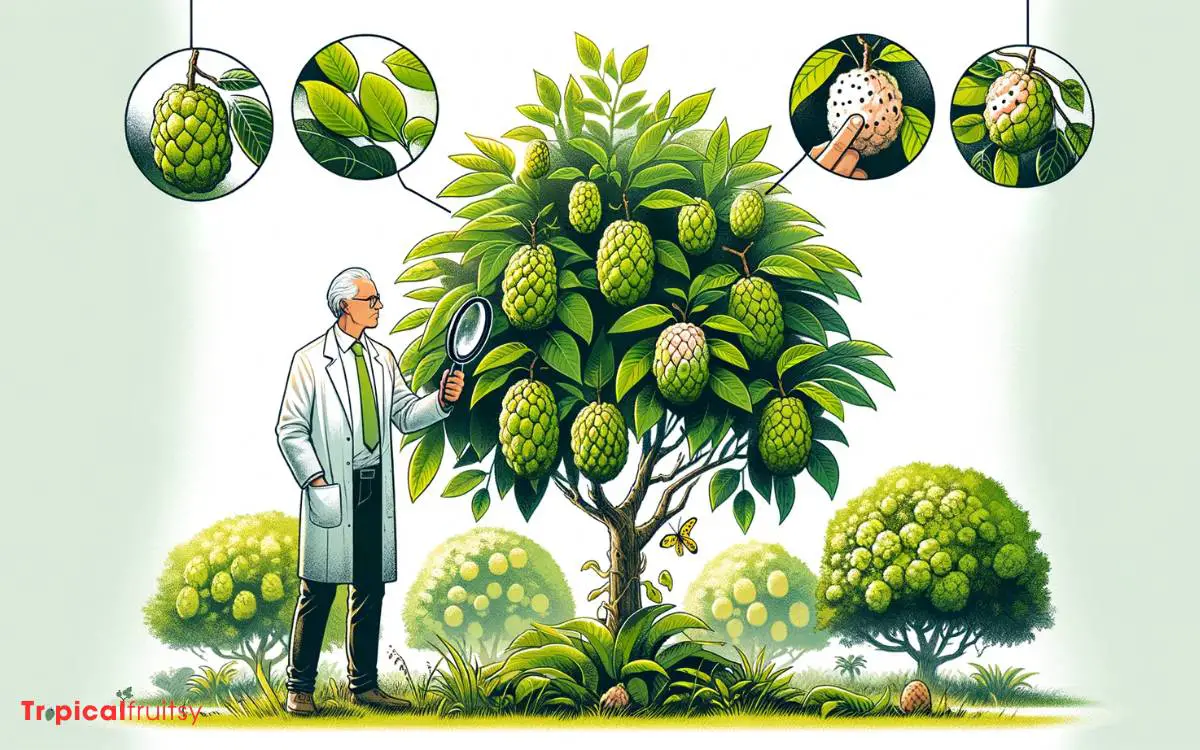
Before pruning my custard apple tree, I check its health, looking for signs of disease, pest infestation, or environmental stress. It’s crucial to identify any issues that could be exacerbated by pruning or that might require specialized treatment.
Here’s what I look for:
- Discoloration of leaves or bark: This can indicate nutrient deficiencies or disease.
- Wilting or drooping leaves: Often a sign of water stress or root problems.
- Evidence of pests: Such as holes in leaves or sawdust-like frass around the tree base.
- Fungal growths or cankers: These may appear on branches or the trunk.
- Abnormal leaf drop: While some leaf drop is normal, excessive shedding can signal health issues.
Addressing these concerns can help ensure a healthy growth cycle post-pruning.
Can I Use the Same Pruning Techniques for a Grafted Custard Apple Tree?
Yes, you can use the same pruning techniques for a grafted custard apple tree as you would for a non-grafted tree. However, you should pay special attention to the branches below the graft union to ensure that you do not inadvertently damage the graft. Proper pruning can help maintain the health and productivity of your grafted custard apple tree.
Step 2: Pruning Techniques Explained
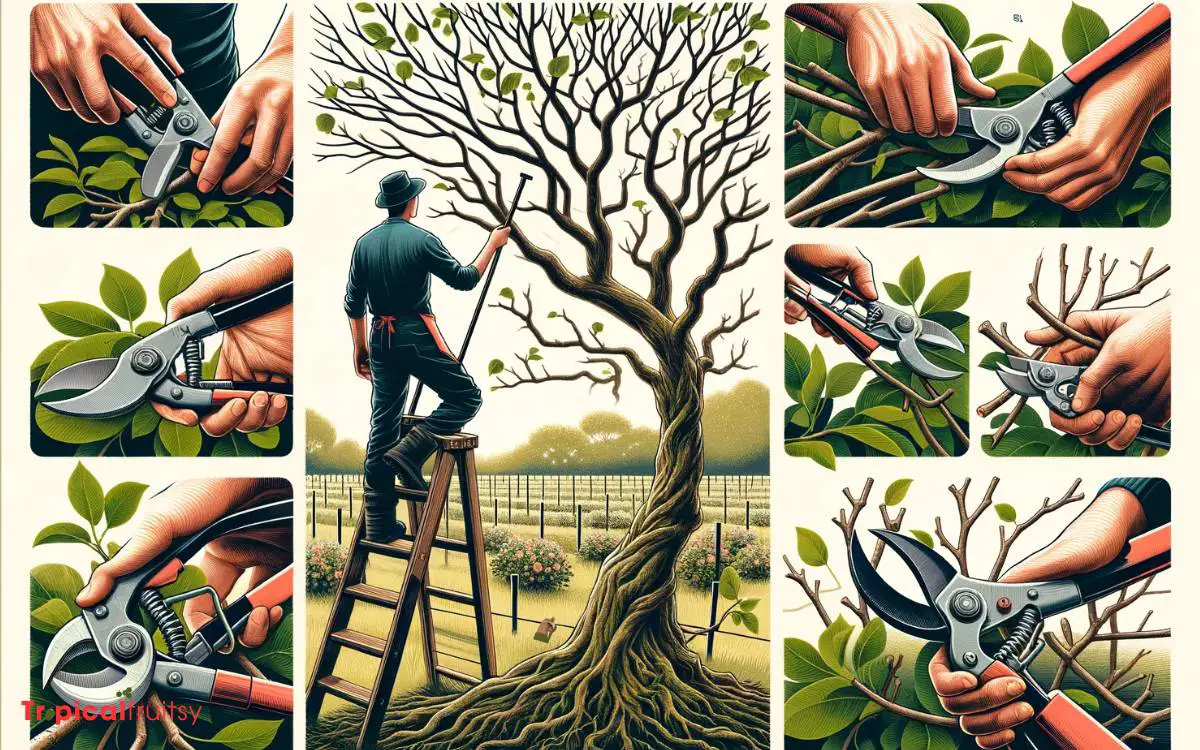
With the health of my custard apple tree assessed, I’m ready to delve into the specific techniques for effective pruning.
Firstly, I identify the three D’s: dead, diseased, and damaged branches, which I’ll remove to maintain the tree’s vigor.
I then thin out crowded areas to improve air circulation and light penetration, vital for fruit development.
I use sharp, clean tools to make precise cuts at a 45-degree angle just above outward-facing buds, encouraging outward growth. I also focus on cutting back the leaders to control the tree’s height, making harvesting easier.
I’m careful not to over-prune, removing no more than one-third of the canopy in a single session to avoid stressing the tree. Each cut is a strategic decision to shape the tree for optimal health and productivity.
Step 3: Aftercare and Maintenance
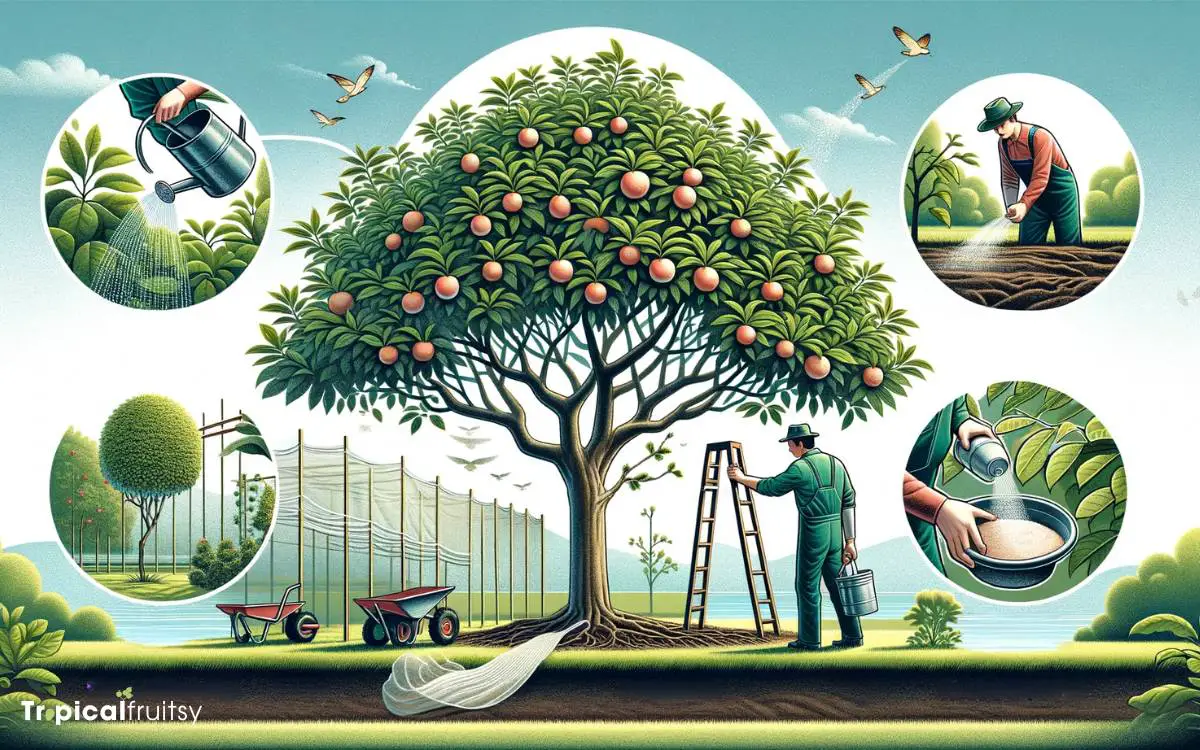
Having pruned my custard apple tree, I’ll now turn my attention to the essential aftercare and maintenance to ensure its recovery and continued health.
The following steps are crucial:
- Watering: I’ll monitor soil moisture and water deeply, avoiding over-saturation to prevent root rot.
- Mulching: I’m applying a layer of organic mulch to conserve moisture and regulate soil temperature.
- Fertilizing: A balanced, slow-release fertilizer will be used to provide the necessary nutrients for healing and growth.
- Pest Management: I’ll keep an eye out for signs of pests and diseases, intervening promptly with appropriate treatments.
- Support: If needed, I’ll add stakes or ties to support the tree as it adjusts to the pruning.
Conclusion
After meticulously pruning my custard apple tree, I’ve witnessed a remarkable transformation. Just last season, a once-overlooked, spindly tree burst into robust health, bearing the sweetest fruits in my garden.
It’s a testament to the power of proper care. Remember, with the right tools and techniques, you’re not just cutting away branches—you’re sculpting a legacy of abundance.
So, tend to your trees with precision, and they’ll reward you with their bounty, season after season.


